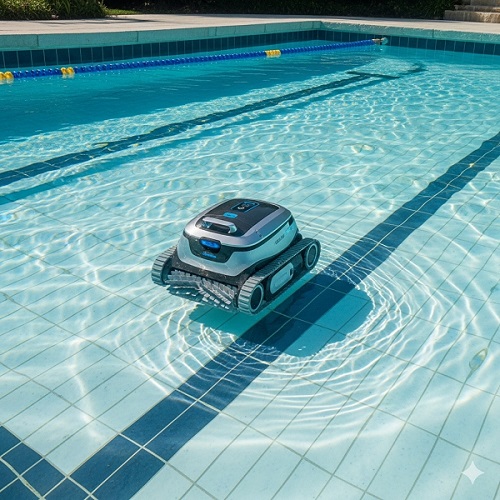
Automatic Pool Vacuum : Advantages & Tips for Buying
If you own a pool, you know how much work goes into keeping it clean. Traditional methods like using a

Swimming pools are one of the best parts of living in Australia. Whether you’re splashing around in the summer heat or enjoying a peaceful view in winter, a clean pool makes all the difference. But with the changing seasons, cleaning the swimming pool needs more than just scooping out leaves.
This guide will walk you through how to clean a pool in Australia—step by step—adjusted for every season. Whether you’re a new pool owner or someone who’s tired of guessing, this article is for you.
Summer means more swimming, which also means more dirt, sunscreen, and debris. Use a skimmer net to remove floating leaves, insects, and any other debris daily. It helps stop buildup before it sinks.
Brushing the pool sides and bottom prevents algae and stains. Use a nylon-bristle brush for concrete pools and a softer one for vinyl or fiberglass.
Manual or robotic pool vacuums help clean up the dirt and debris that sinks. This keeps the water clear and reduces pressure on your pool filter.
Check pH, chlorine, alkalinity, and calcium levels at least twice a week. In summer, pool water evaporates faster, which changes the chemical balance.
1. pH: 7.2 – 7.6
2. Free Chlorine: 1 – 3 ppm
3. Alkalinity: 80 – 120 ppm
Because of higher pool usage, run your pool filter for 8–10 hours daily in summer. Clean the filter cartridges or backwash sand filters weekly.
Leaves, pollen, and cooler evenings bring new cleaning challenges.
As trees start to shed, using a pool cover reduces the mess. It also keeps your water warmer and chemical levels balanced longer.
Check baskets twice a week. Fallen leaves can clog them quickly in autumn.
Since algae grows slower in cooler water, you can reduce chlorine levels slightly, but still maintain hygiene.
Don’t skip vacuuming just because swimming reduces. Algae and dirt can still build up and get worse by winter.
If rainfall increases in your area, keep an eye on water levels. Drain any excess to avoid overflowing.
Some Aussies cover their pools entirely in winter. Others keep it running. Either way, basic cleaning is still necessary.
Cut filter run time to 4–6 hours daily, depending on water clarity. If the pool is covered and unused, run it every few days.
Winter storms can blow debris and dust into your pool. After heavy rain or winds, skim, vacuum, and rebalance your water chemistry.
A winterising kit includes algaecide, scale inhibitors, and chlorine tablets. This keeps your pool clean and reduces algae risk during off-season.
You won’t need to test weekly, but check once every 3–4 weeks to ensure levels are stable. Cold water still needs balance to stay clean.
Safety first. If your pool is not in use, a secured pool cover or fencing is important to prevent accidents and reduce dirt accumulation.
Spring means warmer days and time to prep your pool for summer fun.
If you’ve used a pool cover in winter, remove it carefully and clean it. Allow it to dry before storing to prevent mould.
“Shocking” means adding a high dose of chlorine to kill bacteria and algae. Do this when reopening your pool for use.
Brush the pool walls, vacuum thoroughly, and clean out skimmer baskets. A deep spring clean ensures fresh start for the swim season.
Evaporation and maintenance may have lowered your water level. Fill the pool back to halfway up the skimmer box.
Run the filter for at least 8 hours a day and monitor the water’s clarity. Replace or clean filters if clogged.
1. Skimmer Net – For daily debris collection
2. Pool Brush – Prevents algae buildup
3. Vacuum (Manual or Robotic) – For thorough floor cleaning
4. Water Test Kit – pH and chlorine checking
5. Leaf Rake – For heavy-duty autumn leaf removal
6. Filter Cleaner – Keeps pump system running efficiently
1. Use Pool Alarms or Motion Sensors: In stormy or windy areas, they notify when debris enters.
2. Install a Pool Blanket Roller: Makes it easier to cover and uncover your pool.
3. Schedule Monthly Professional Service: Even with DIY cleaning, a monthly check by an expert helps keep long-term costs down.
4. Keep a Logbook: Track cleaning dates, chemical adjustments, and filter changes for better maintenance.
Cleaning the swimming pool might sound like a chore, but with a clear, seasonal routine, it becomes a simple part of home care. By understanding how to clean your pool in Australia—from summer heatwaves to winter storms—you ensure your pool stays beautiful, safe, and ready whenever you are.
Don’t wait for algae or dirty water to remind you. Stick to this seasonal guide and enjoy crystal-clear water all year round.

If you own a pool, you know how much work goes into keeping it clean. Traditional methods like using a

Keeping a pool clean is not easy for many people. It takes time to scrub the floor, clear the walls,
